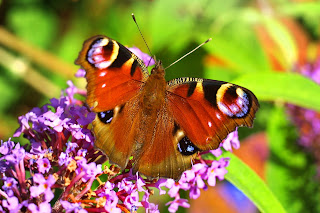Kingdom: Animalia
Phylum: Arthropoda
Class: Insecta
Order: Lepidoptera
Suborder: Rhopalocera
Class: Insecta
Order: Lepidoptera
Suborder: Rhopalocera
Moths and butterflies belong to the order Lepidoptera, meaning scale winged. Butterflies comprise of the subfamilies Papilionoidea (true butterflies), Hesperioidea (skippers) and Hedyloidea (moth-butterflies). All the many other families within the Lepidoptera are referred to as moths.
2.
There are four steps in becoming a butterfly
These are egg, larvae (caterpillar), pupa, and adult. Caterpillars shed their skin as they grow, then form a chrysalis and change into a butterfly. This process is called metamorphosis, which comes from the Latin words for "changing shape."
These are egg, larvae (caterpillar), pupa, and adult. Caterpillars shed their skin as they grow, then form a chrysalis and change into a butterfly. This process is called metamorphosis, which comes from the Latin words for "changing shape."
3. Some
are big. And I mean big!
The
largest known butterfly in the world is the Queen Alexandra Birdwing (Ornithoptera
alexandrae) from the rain forests of Papua New Guinea. This rare
butterfly has a wingspan of 30 cm. The Goliath birdwing (Ornithoptera
goliath), also from the rain forests of Papua New Guinea, is also one of
the largest butterflies with an average wingspan of 28 cm.
 |
| Western pygmy blue |
4.
Some are small
The smallest known butterfly is the Western Pygmy Blue (Lycaenidae), which are found in North American and Africa. They have wingspans between 6-12 mm.
The smallest known butterfly is the Western Pygmy Blue (Lycaenidae), which are found in North American and Africa. They have wingspans between 6-12 mm.
5.
They have scales
The powder that rubs off when you touch a butterfly's wing is actually tiny scales. The butterfly sheds these scales throughout its lifetime. It is not true that if you touch a butterfly’s wing and the ‘powder’ rubs off that the butterfly will not be able to fly.
The powder that rubs off when you touch a butterfly's wing is actually tiny scales. The butterfly sheds these scales throughout its lifetime. It is not true that if you touch a butterfly’s wing and the ‘powder’ rubs off that the butterfly will not be able to fly.
 |
| Monachs migrating |
Many butterflies, such as the Monarch butterfly, are migratory and capable of long distance flights. Butterflies migrate during the day and use the sun to orient themselves.
Monarchs
have been known to migrate over 1800 miles (3000 km), and can fly 600 miles (1000
km0 without stopping.
7. They can shift some
Butterflies can attain a flight speed of over 30 miles (50 km) per hour. The fastest butterflies are the skippers, which can fly at 37 miles (60 km) per hour. Most butterflies travel at 5-12 miles (8-20 km) per hour.
8.
They are great pollinators
Butterflies are the second largest group of pollinators.....next to bees.
Butterflies are the second largest group of pollinators.....next to bees.
 |
| Peacock butterfly |
9. Mimicry in butterflies is common
This may be to imitate other species, or even other butterflies, for defence purposes.
The palatable North American species Limenitis archippus bears a quite remarkable resemblance to the highly toxic Monarch butterfly Danaus plexippus.The Common Mormon butterfly in India has female morphs which imitate the unpalatable red-bodied swallowtails.
A butterfly's taste sensors are located on the bottom of its feet. They can taste their food just by standing on it. They don't have mouths that allow them to bite or chew, instead they have a long straw-like structure called a proboscis which they use to drink nectar and juices.
For related articles
Ant facts
Bee facts
Butterfly facts
How big is a giant earthworm?
Is the sea sponge a plant or an animal?
Ladybirds
Keystone species
Moth Facts
Sea animals: Sea Anemones
Sea cucumber facts
Seahorse facts
Star Starfish
The house spider
The false widow spider
The seahorse
The sea cucumber
What is a sea sponge?
What is a cuttlefish?
What is a ladybug?
What is a sea anemone?
What is a starfish?
What is the difference between a butterfly and a moth?
What is the difference between a bee and a wasp?
What is the difference between a millipede and a centipede?
What is the difference between a wasp and a hornet?
Worm facts
World largest insect


No comments:
Post a Comment